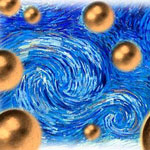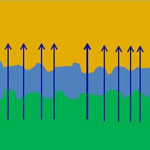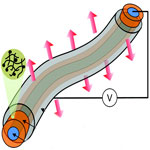Showing Spotlights 1529 - 1536 of 2780 in category All (newest first):
 Technological advances have made desalination and demineralization of seawater feasible, albeit expensive, solutions for increasing the world's supply of freshwater. Among various desalination technologies, reverse osmosis membranes have been widely used for water reclamation. However, external energy required and high operational pressure used (above 75 bar for reverse osmosis desalination and 25 bar for reverse osmosis water recovery from wastewater) make reverse osmosis membrane water reclamation processes energy intensive - not exactly an advantage given the rising cost of energy and the negative climate impact of fossil fuels. Researchers have now demonstrate the novel concept of a "desalination battery", which operates by performing cycles in reverse on our previously reported mixing entropy battery.
Technological advances have made desalination and demineralization of seawater feasible, albeit expensive, solutions for increasing the world's supply of freshwater. Among various desalination technologies, reverse osmosis membranes have been widely used for water reclamation. However, external energy required and high operational pressure used (above 75 bar for reverse osmosis desalination and 25 bar for reverse osmosis water recovery from wastewater) make reverse osmosis membrane water reclamation processes energy intensive - not exactly an advantage given the rising cost of energy and the negative climate impact of fossil fuels. Researchers have now demonstrate the novel concept of a "desalination battery", which operates by performing cycles in reverse on our previously reported mixing entropy battery.
Feb 7th, 2012
 Vanadium dioxide (VO2) is a leading candidate material for the fabrication of thermochromic films and coatings that will find special applications in a new generation of 'smart' glass that can change infrared transmittance by responding to environmental temperature, while maintaining visible transparency. This kind of smart windows may be especially useful for locations with hot summers and/or cold winters. In addition to its temperature-responsive thermochromism these films also exhibit UV-shielding properties. Previously, we reported on a novel technique to fabricate large-area VO2 films suitable for mass production. The same research team has now developed an alternative technique for the large-scale, mass production of thermochromatic VO2 films.
Vanadium dioxide (VO2) is a leading candidate material for the fabrication of thermochromic films and coatings that will find special applications in a new generation of 'smart' glass that can change infrared transmittance by responding to environmental temperature, while maintaining visible transparency. This kind of smart windows may be especially useful for locations with hot summers and/or cold winters. In addition to its temperature-responsive thermochromism these films also exhibit UV-shielding properties. Previously, we reported on a novel technique to fabricate large-area VO2 films suitable for mass production. The same research team has now developed an alternative technique for the large-scale, mass production of thermochromatic VO2 films.
Feb 6th, 2012
 Apart from graphene, other two-dimensional structures are also known to have unique properties which researchers are eager to exploit for novel nanotechnology applications in nanoelectronics and sensor or energy storage technology. Particular interest has been on semiconducting materials, such as molybdenum disulfide (MoS2), an abundant material in nature, which exhibits the unique physical, optical and electrical properties correlated with its single-layer atomic layer structure. Researchers have now fabricated a mechanically exfoliated single-layer MoS2 based phototransistor and investigated its electric characteristics in detail. These new findings show that, when compared with a 2D graphene-based device, the single-layer MoS2 phototransistor exhibits a better photoresponsivity.
Apart from graphene, other two-dimensional structures are also known to have unique properties which researchers are eager to exploit for novel nanotechnology applications in nanoelectronics and sensor or energy storage technology. Particular interest has been on semiconducting materials, such as molybdenum disulfide (MoS2), an abundant material in nature, which exhibits the unique physical, optical and electrical properties correlated with its single-layer atomic layer structure. Researchers have now fabricated a mechanically exfoliated single-layer MoS2 based phototransistor and investigated its electric characteristics in detail. These new findings show that, when compared with a 2D graphene-based device, the single-layer MoS2 phototransistor exhibits a better photoresponsivity.
Feb 3rd, 2012
 Back in the early 2010s, food nanotechnology seemed to be a very hot topic and large industrial food companies were eager to explore new opportunities offered by nanotechnology applications. Then, as critical voices from NGOs and regulators appeared, the food industry went into silent mode. But that doesn't mean that food nanotechnologies aren't being researched and developed in labs around the world. Here is an overview of what nanotechnology applications are currently being researched, tested and in some cases already applied in food technology. It appears that we are still some way from seeing "Frankenfoods" in supermarket shelves. According to a recent commentary by an FDA official, what's holding back the introduction of nanofoods is the hesitation of the food industry, fearing a public backlash along the lines of what happened wit genetically modified foods.
Back in the early 2010s, food nanotechnology seemed to be a very hot topic and large industrial food companies were eager to explore new opportunities offered by nanotechnology applications. Then, as critical voices from NGOs and regulators appeared, the food industry went into silent mode. But that doesn't mean that food nanotechnologies aren't being researched and developed in labs around the world. Here is an overview of what nanotechnology applications are currently being researched, tested and in some cases already applied in food technology. It appears that we are still some way from seeing "Frankenfoods" in supermarket shelves. According to a recent commentary by an FDA official, what's holding back the introduction of nanofoods is the hesitation of the food industry, fearing a public backlash along the lines of what happened wit genetically modified foods.
Feb 2nd, 2012
 Despite offering technological innovation in biosensing and THz metamaterials design, plasmonics faces fundamental physical limitation in the visible frequency band due to high absorptive losses of metals. The major setback to practical applications of plasmonics is high radiative and/or dissipative losses of noble-metal nanostructures in the visible frequency range. Although metal nanostructures enable unrivalled high concentration of optical energy well beyond the diffraction limit, a significant part of this energy is converted into an inherently lossy kinetic motion of free electrons in metal, and is dissipated rapidly as heat. Researchers have now demonstrated a new way to efficiently trap, enhance and manipulate light in nanoscale structures and nanopatterned thin films. This novel approach can significantly improve performance of photonic and electronic devices such as nanosensors, thin-film organic solar cells and optical nanochips.
Despite offering technological innovation in biosensing and THz metamaterials design, plasmonics faces fundamental physical limitation in the visible frequency band due to high absorptive losses of metals. The major setback to practical applications of plasmonics is high radiative and/or dissipative losses of noble-metal nanostructures in the visible frequency range. Although metal nanostructures enable unrivalled high concentration of optical energy well beyond the diffraction limit, a significant part of this energy is converted into an inherently lossy kinetic motion of free electrons in metal, and is dissipated rapidly as heat. Researchers have now demonstrated a new way to efficiently trap, enhance and manipulate light in nanoscale structures and nanopatterned thin films. This novel approach can significantly improve performance of photonic and electronic devices such as nanosensors, thin-film organic solar cells and optical nanochips.
Jan 31st, 2012
 Thermal interface materials (TIMs) are essential ingredients of thermal management. TIMs are applied between the heat source, e.g. computer chips, and heat sinks and their function is to fill the voids and grooves created by imperfect surface finish of mating surfaces. Conventional TIMs filled with thermally conductive particles require high volume fractions of filler particles. But now, researchers have achieved a record enhancement of the thermal conductivity of TIMs by addition of an optimized mixture of graphene and multilayer graphene. The thermal conductivity of the epoxy matrix material was increased by an impressive factor of 23 at the 10 volume % of graphene loading. The epoxy-graphene composite preserved all the properties required for industrial TIM applications.
Thermal interface materials (TIMs) are essential ingredients of thermal management. TIMs are applied between the heat source, e.g. computer chips, and heat sinks and their function is to fill the voids and grooves created by imperfect surface finish of mating surfaces. Conventional TIMs filled with thermally conductive particles require high volume fractions of filler particles. But now, researchers have achieved a record enhancement of the thermal conductivity of TIMs by addition of an optimized mixture of graphene and multilayer graphene. The thermal conductivity of the epoxy matrix material was increased by an impressive factor of 23 at the 10 volume % of graphene loading. The epoxy-graphene composite preserved all the properties required for industrial TIM applications.
Jan 30th, 2012
 OLEDs - organic light-emitting diodes - are full of promise for a range of practical applications. OLED technology is based on the phenomenon that certain organic materials emit light when fed by an electric current and it is already used in small electronic device displays in mobile phones, MP3 players, digital cameras, and also some TV screens. OLEDs in fiber form could lead to revolutionary applications by integrating optical and optoelectronic devices into textile. Combined with nanoelectronic devices, we might one day see flexible optical sensors and display screens woven into shirts and other garments. You could literally wear your next-generation smart phone or iPad on your sleeves; including the solar panels to power them.
OLEDs - organic light-emitting diodes - are full of promise for a range of practical applications. OLED technology is based on the phenomenon that certain organic materials emit light when fed by an electric current and it is already used in small electronic device displays in mobile phones, MP3 players, digital cameras, and also some TV screens. OLEDs in fiber form could lead to revolutionary applications by integrating optical and optoelectronic devices into textile. Combined with nanoelectronic devices, we might one day see flexible optical sensors and display screens woven into shirts and other garments. You could literally wear your next-generation smart phone or iPad on your sleeves; including the solar panels to power them.
Jan 27th, 2012
 In a project funded by the Danish Environmental Protection Agency, researchers have initiated the development of a screening tool called NanoRiskCat for the evaluation of exposure and hazard of nanomaterials contained in products for professional and private use. The project's aim was to identify, categorize and rank the possible exposure and hazards associated with a nanomaterial in a product. NanoRiskCat is using a stepwise approach based on existing data on the conventional form of the chemical as well as the data that may exist on the nanoform. However, the tool still needs to be further validated and tested on a series of various nano products in order to adjust and optimize the concept and thereby to achieve a screening tool as informative and practical as possible.
In a project funded by the Danish Environmental Protection Agency, researchers have initiated the development of a screening tool called NanoRiskCat for the evaluation of exposure and hazard of nanomaterials contained in products for professional and private use. The project's aim was to identify, categorize and rank the possible exposure and hazards associated with a nanomaterial in a product. NanoRiskCat is using a stepwise approach based on existing data on the conventional form of the chemical as well as the data that may exist on the nanoform. However, the tool still needs to be further validated and tested on a series of various nano products in order to adjust and optimize the concept and thereby to achieve a screening tool as informative and practical as possible.
Jan 25th, 2012
 Technological advances have made desalination and demineralization of seawater feasible, albeit expensive, solutions for increasing the world's supply of freshwater. Among various desalination technologies, reverse osmosis membranes have been widely used for water reclamation. However, external energy required and high operational pressure used (above 75 bar for reverse osmosis desalination and 25 bar for reverse osmosis water recovery from wastewater) make reverse osmosis membrane water reclamation processes energy intensive - not exactly an advantage given the rising cost of energy and the negative climate impact of fossil fuels. Researchers have now demonstrate the novel concept of a "desalination battery", which operates by performing cycles in reverse on our previously reported mixing entropy battery.
Technological advances have made desalination and demineralization of seawater feasible, albeit expensive, solutions for increasing the world's supply of freshwater. Among various desalination technologies, reverse osmosis membranes have been widely used for water reclamation. However, external energy required and high operational pressure used (above 75 bar for reverse osmosis desalination and 25 bar for reverse osmosis water recovery from wastewater) make reverse osmosis membrane water reclamation processes energy intensive - not exactly an advantage given the rising cost of energy and the negative climate impact of fossil fuels. Researchers have now demonstrate the novel concept of a "desalination battery", which operates by performing cycles in reverse on our previously reported mixing entropy battery. 
 Subscribe to our Nanotechnology Spotlight feed
Subscribe to our Nanotechnology Spotlight feed





